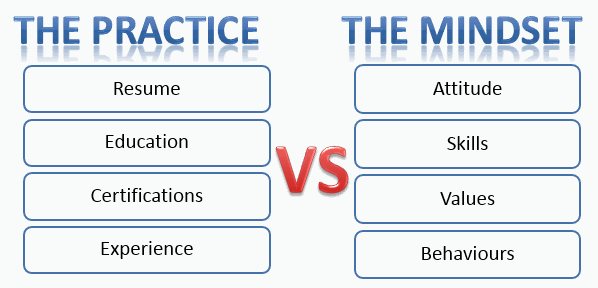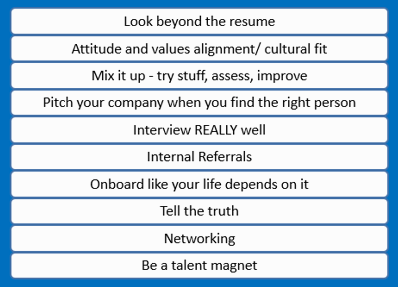|
Software Development Magazine - Project Management, Programming, Software Testing |
|
Scrum Expert - Articles, tools, videos, news and other resources on Agile, Scrum and Kanban |
Hiring for Agility - Mindset Matters in an Agile Organisation
Nadia Smith, Head of Quality Assurance (Acting), @NadiaSmith Sportsbet, https://workatsportsbet.com.au
"It is our people that differentiate us". We have all heard it. As hiring managers, we have likely said it a number of times ourselves. It is vital for engagement, growth and success to have the right people in place.
Finding the right people highlights the importance of hiring for agility. Hiring for agility will enable you to build and develop the team you will require to take you to your desired future state.
I do believe people make the difference. I have been a hiring manager for 8 years, hiring for Sales, Marketing, Administration, Events, Management, Software Development and most recently, Quality Assurance, roles and teams.
Agile vs. agility
For the purpose of this article, Agile refers to 'the Practice' as resume, education, certifications and experience, versus agility 'the Mindset' as attitude, skills, values and behaviours.
Hiring for agility looks beyond the resume, certifications, education and experience, and instead considers values, behaviour and attitude, the mindset.

Being part of a companywide Agile transformation has provided a number of learning opportunities, the two most integral being the role culture plays, and the behaviours of the team as they adapt to change. Mindset is the difference between ongoing transformation success and struggle.
Stating you are now an Agile organisation is only half the battle won. Ongoing commitment to this new world, smarter ways of working and continual improvement is what will ensure your transformation effort and energy is not wasted.
- To do that, you need great teams.
- To have that, you need the right people.
- Currently many are recruiting for Agile; however, we need to recruit for agility.
- We need to recruit for culture.
Culture
Culture drives change, facilitates resilience for change, and enables engagement and success.
Culture should be the driving force behind your recruitment strategy. Understanding the cultural influence of your workplace is key to understanding the mindset you will need to hire for.
It is important to assess the culture that is in play right now and determine if that same culture will be the ethos to take you forward as you progress your Agile transformation. Possibly your culture may require a tweak, which means you will need the people with the right mindset to make that possible. Your future desired state is where you are heading. The people that will help achieve that vision will need to possess the behaviours, attitude and values to enable that.
Behaviours & Values
Be clear on the behaviours that appeal. This will provide clarity with what to look for, and to set expectations.
Outline the values that your business lives by and provide opportunity for candidates to ensure there is a value alignment. Values are core to a person, and do not change often. Strong value alignment with the organisation creates a powerful working relationship.
Recruitment
The traditional recruitment approach of resumes and keyword searches determining who gets through to an interview is ultimately flawed.
The traditional recruitment approach may be disregarding the candidates that could be those needed to help your continued transformation success, those that can take your company to the next level, and those that have the attitude and mindset to change the game.
I have two examples of team members that may not have joined us if we had stuck to the traditional approach to recruitment, as they would likely not have made it through to an interview.
The first, a Developer, very young, with no formal certifications and minimal work experience. He was referred by another team member with the advice that, although he didn't have a degree or a lot of experience, he would be a great cultural fit for us, gets through a lot of work and has a resilient attitude. The interview went great and he is indeed one of our most resilient and flexible team members, embracing change and giving everything a go, always with a smile.
The second, a Business Analyst. Since day one with us, he has 'fit in' culturally. He is well-liked and respected as a team player, is an active learner and a problem solver. During the recruitment process, due to a career direction change to better align with his values and passions, his experience as a BA was very minimal, his certifications were in progress, his experience had been in IT Consulting. If we had only considered resume, certifications and experience, rather than looking for the right fit for our culture and looking for the right mindset, he may not be a key team member today.
I provide an opposite example, but equally important to consider. We had a highly skilled and experienced individual, who was brilliant and his work could not be faulted. He had the perfect resume to match our position description; he was educated and had all the certifications. We hired him.
However, the way we worked, our focus on team collaboration and team success, the need to speak openly within teams and at stand-ups, the constant changing of priorities, and desire to cross-skill in teams, was not the right fit for him. He elected to move on.
Resumes do not talk to mindset.
Keyword searches, education and credential demands may limit your options, you may miss out on the individuals that have the attitude and adaptability to take you from your current state to your future state, and will help evolve your Agile journey.
To look beyond the resume, you need to get creative in your means to find and attract the right people. You will also need to interview really well.
Interview Well
Here are some points to consider when interviewing.

An Agile workplace is not a good fit for those individuals that thrive for the opportunity to be the 'hero'. Placing team success above individual success is the desired behaviour.
Provide opportunity at the interview to be inspired. Inspiring people will inspire those around them and that makes for a great place to work.
With stand-ups, retrospectives and showcases, plus the collaborative working environment, it is important that a potential team member is aware of the need for good communication skills and the necessity to speak to groups.
Encourage storytelling to learn of the experiences the candidate may share with regards to collaboration and resilience. Look for stories that identify if the candidate struggles with constantly changing priorities.
In our organisation and many organisations, it is important to strive for good results, and to truly care about your customers and want what's best for them.
Finally, practice makes perfect: practice your interviewing technique and prepare ahead of every interview.
Consider when hiring
As hiring managers try the following if you are not already experimenting with them.

Look beyond the resume, be careful the resume does not limit you from meeting great candidates.
Ensure the attitude and values of the candidate will be a good cultural fit with your workplace.
Experiment. Find what works for your hiring managers, assess, improve. Candidates are individuals and no two people are the same. You should have a number of tools in your toolkit to help your hiring managers discover the right people for the team.
When you happen to meet someone that has the mindset you are looking for, pitch your company to him or her. The right people are hard to find, when you do, ensure you put your best foot forward. Even if a role doesn't yet exist, always take the opportunity to let a potential candidate know about your company, culture and goals. Let them know you are interested.
Interview really well. The interview provides the best opportunity to learn about the candidate's values and their mindset.
Tell the truth. Be honest about the workplace culture, team structure, number of teams, pending changes, the frequency of change and expectations.
Tap into your own team for referrals. People work well with people they like, productivity is higher and engagement is positive. Ask internally for referrals, you will be surprised at the connections and networks within the team.
Networking is an excellent way to meet people that could be future team members. Without the formalities of interviews and the recruitment process, networking events provide the opportunity to have relaxed conversations with a variety of people.
At our company, we host a lot of community events and attend many community meet-ups. These events provide opportunities to showcase your company, your workplace, attract interest and spark conversations. Through networking at these events, I have met and hired current team members.
Be a talent magnet, be known as a great place to work that embraces innovation and leads in the market, this will attract people to your company.
Respect and value the onboarding process. You have invested a lot of time finding and hiring the right people for your organisation, the next step is to ensure your latest recruits have the space and time to learn about the company, strategy, structure, expectations, set goals, observe the end to end process in action and meet/ chat with people they will be working with.
Agility & Culture
Recruit for agility. Recruit for cultural fit.
Find people with a "can do" attitude, who want to evolve, who show resilience, who embrace ambiguity, and have the desire to succeed.
These people will evolve your Agile journey, enable growth and create success.
Related Agile Articles
Immersive Interviewing - Building Great Agile Software Teams
Choosing Candidates for Large Company Agile Initiative
More Agile Knowledge
Click here to view the complete list of archived articles
This article was originally published in the Summer 2016 issue of Methods & Tools
|
Methods & Tools Software Testing Magazine The Scrum Expert |



